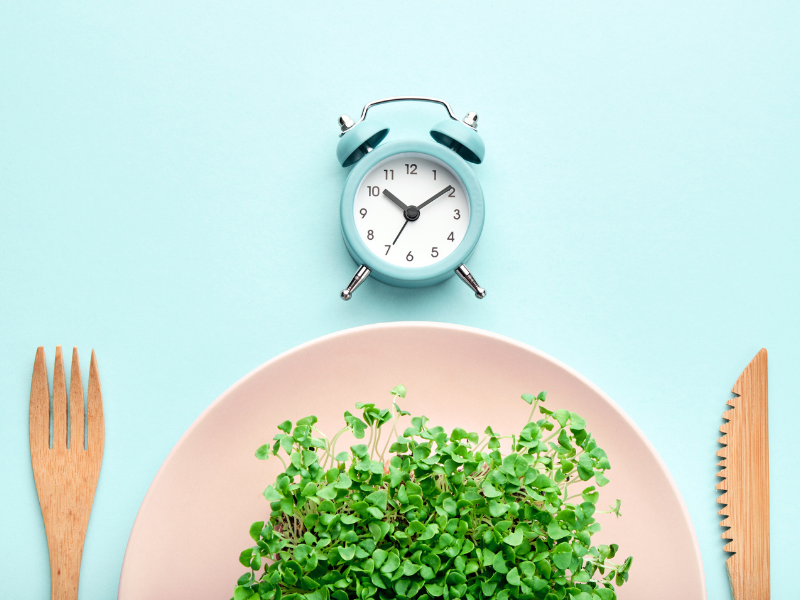
Intermittent fasting is a blanket term for a variety of meal timing schedules that switch between voluntary fasting and non-fasting over a given period of time. Research suggests that intermittent fasting offers a plethora of rich health benefits when followed consistently and one that may well suit women midlife.
Often abbreviated to IF, intermittent fasting has been positively associated with lowering caloric intake to help boost weight loss, burning unwanted fat, resetting metabolism, detoxing, as well as, reducing the risk of developing age-related illnesses or disease.
For women over 50, intermittent fasting is a great option for supporting the many changes that occur within the body midlife including slower metabolism, sleep issues, digestive changes, aching joints and changes in muscle mass.
Moreover, it helps reduce fat, especially unhealthy (dangerous) belly fat, which is a concern not only because of how it makes you feel in your clothes but also for health implications. Reducing it can significantly lower your risk for serious health issues such as high cholesterol, hypertension, diabetes, heart attack, and more.
The importance of healthy eating, especially once you turn 50 or hit menopause, cannot be underestimated. Intermittent fasting is a great way to help retain your vitality and stay as active as possible, for as long as possible to ensure you age gracefully and increase longevity.
Read on to discover how intermittent fasting can help benefit you. We will look at what it is, how it works, which foods to eat and top tips to help support and sustain your body to to succeed with intermittent fasting.
What Is Intermittent Fasting?
Intermittent fasting, also known as time-restricted eating or intermittent energy restriction, is a way of eating that swings between voluntary fasting (or lowered caloric consumption) and not fasting, over a specific given time schedule. There are 3 main modes of intermittent fasting which include daily time-restricted eating, alternate day-fasting (ADF) and periodic fasting.
- Time restricted: eating between a certain number of hours per day. E.g. 16:8 or 14:10 etc or skipping a meal.
- ADF (complete or modified) is the most stringent as more days than not are included in fasting. Modified means you consumer 25% of usual energy needs and complete means you consume zero calories.
- Periodic or whole-day fasting involves fasting over consecutive days e.g. 5:2 diet. This is quite extreme and if complete fasting is not appealing, you can adopt a 25% calorie intake of between 5-700 calories on fast days.
How Does Intermittent Fasting Work?
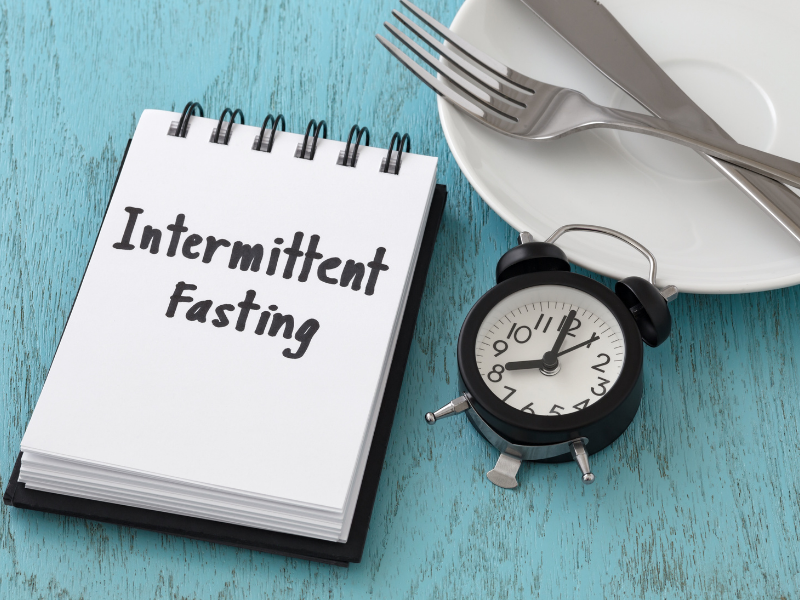
Intermittent fasting pushes you to eat in a given window of time. It neither promotes starvation, nor does it offer over consumption. It also does not support the consumption of unhealthy foods during non fasting times. The focus is on how and when you eat versus what you eat which works really well for some people.
The most convenient way to start is to create a schedule that requires you to fast for 12 to 16 hours a day. During the non-fasting time, you eat regular healthy meals and snacks.
Considering that most people sleep for half of this time, maintaining this feeding schedule is easier than it may first of all sound. Moreover, water, tea and coffee (without milk, cream or sugar) are allowed in abundance at any time without the consequence of breaking the fast.
What Makes Intermittent Fasting Work?
Intermittent fasting health benefits are thought to result from a process called metabolic switching, which is when the body goes into a fasting state and begins using body fat instead of glucose to meet its energy needs.
Intermittent fasting helps maintain the body’s regular interplay between the hormone insulin and blood glucose, avoiding insulin resistance (which is when the body doesn’t respond properly to it). This metabolic switching also tells the body to turn on various maintenance and repair systems, which help in the prevention of illness and disease.
According to one study, the main hypotheses behind the mechanisms of action for what makes intermittent fasting regimens successful are the several factors that influence metabolic regulation via effects on (a) circadian rhythms, (b) the gut flora and fauna, and (c) modifiable lifestyle behaviours e.g. sleep.
Others believe that intermittent fasting works because the limited window of opportunity for consuming food reduces and naturally helps them limit their calorie intake. They simply don’t have enough time to eat the same amount of food as they normally do.
Another factor to consider is that people become more mindful about the kinds of food they consume and tend to stay away from processed carbs, unhealthy fat, and empty calories.
Examples of Intermittent Fasting Programmes
Intermittent fasting can be tailored to your own individual lifestyle and you should develop an eating schedule that works for you for the best intermittent fasting results.
Some examples of intermittent fasting programmes include the following:
12-12: This means that you fast for 12 hours and non-fast for the other 12. This could be as simple as skipping breakfast and eating a late lunch, or alternatively, eat earlier in the day and stop eating around tea time. This is one of the most popular intermittent fasting programmes to adhere to and many women over 50 opt for this option.
16-8: This programme may well increase the speed in which you see results by eating only 2 meals per day and enjoying a healthy snack in between. All your meals should be consumed in an 8-hour window. E.g. your 8 hour window may be set between 9am until 5am at which point you stop eating. Alternatively 10 until 6 is also a good option too.
5-2: schedule: This is perhaps one of the most rigorous and testing as it has more days where you fast for longer and it may not fit in with your daily life/work schedule. A more realistic approach could see you adopt a 12 or 16-hour fast for 5 days and then relax your fasting schedule for the remaining two days. For example, many people fast during the week and then consume food normally during the weekend.
Every-other-day fasts: Another variation calls for very restricted calories on alternate days so you have a day on and a day off. For example, you could keep your calories under 500 on one day and then eat normally the next day.
Choosing the intermittent fasting programme that works best for you and your lifestyle is also essential for being able to successfully sustain it. You can try it our and see which one works best for you.
Another added benefits is that this kind of diet allows you to take time out for the odd special occasion to treat yourself. That said consistency is key for achieving good results.
Benefits of Intermittent Fasting

The benefits of intermittent fasting extend far beyond just calorie restriction and weight loss. While some nutrition experts contend that intermittent fasting is beneficial because it naturally limits the food consumption, there are other opinions about how beneficial abstaining from food for several hours a day does more than just limit the number of calories you consume.
Intermittent fasting has increased considerably over the last few years due to the many health benefits it provides but also because ultimately, it does not restrict your food choices which is key for being able to sustain this style of eating for longer periods of time. According to WebMD, many studies demonstrate how fasting can improve your metabolism, cardiovascular and cognitive health, and possibly prevent disease and illnesses. It can also ward off certain muscle, nerve, and joint disorders which can affect women over 50.
For midlife women, intermittent fasting could be a great option for switching up a dietary regime given the many health benefits it provides. Specifically considering the challenges faced with weight gain, especially stubborn belly fat.
Intermittent Fasting Benefits for Acid Reflux

Digestive issues often plague women over 50 so IF could provide a good solution to counter this.
GERD, reflux and indigestion have all been shown to improve by stopping eating earlier on in the evening. Digestive issues are commonplace in women over 50 so this could be a great way to redefine the way in which you eat to address several issues.
Intermittent fasting allows your GI tract to rest and can help balance out stomach acid. It is important to know that Intermittent fasting doesn’t mean you have to let your body enter starvation mode and go several hours without replenishing it with food. Be mindful during fasting to eat bone broth and drink soothing teas.
Best Intermittent Fasting Foods To Eat
The great thing about intermittent fasting is there are no specifications or restrictions about what type or how much food to eat. That said, fast food and junk food will not help. A well-balanced diet is key to succeeding when you adopt an intermittent fasting dietary regime and this will ensure that you stick to it long term. Like anything there are no quick easy fixes when it comes to health.
For women over 50 intermittent fasting is both a great way to reduce calories, increase healthy foods, allow the body to rest for long periods of time and rejuvenate itself as well as burn fat and lose weight. If losing weight is your goal, especially belly fat, you should focus on nutrient-dense foods like green veggies, whole grains, legumes, beans, nuts and seeds, as well as high proteins. Adding high fibre, unprocessed foods will increase feelings of satiety faster and for longer.
We detail below some of the very best foods to choose to add to your diet to help your fasting efforts. This list of foods is also super helpful for naturally boosting collagen in the body which is also essential for women over 50 to ensure the structure and integrity of their skin remains. Read our full article about foods to naturally boost collagen right here!
1. H2O
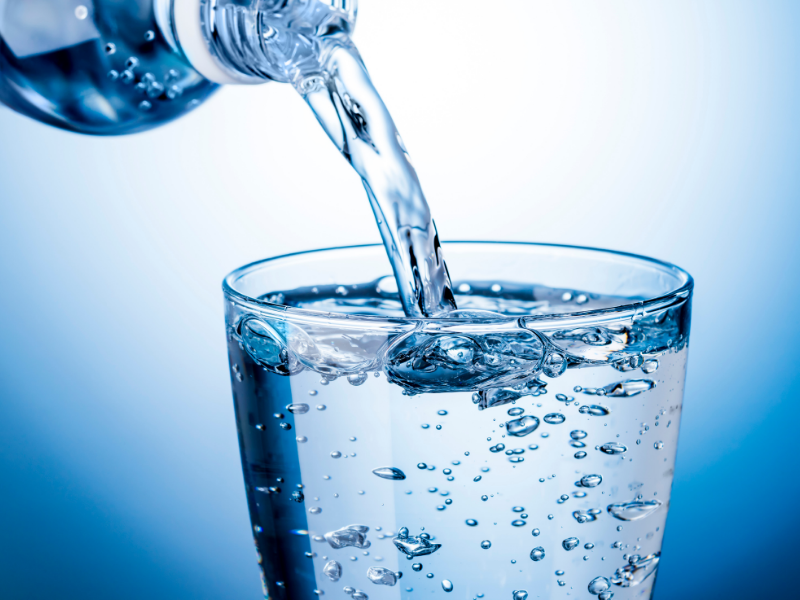
This champion mineral, albeit not a food, is the backbone to mastering intermittent fasting programme. Not without standing, water is THE most important element for every organ in your body and without it you can welcome in headaches, fatigue and dehydration. Whether you drink it plain, as herbal tea, infused with lemon or mint, make water your best friend during intermittent fasting as it works to keep you feeling fuller for longer as well as hydrating the body to ensure optimal health and well-being.
2. Avocado
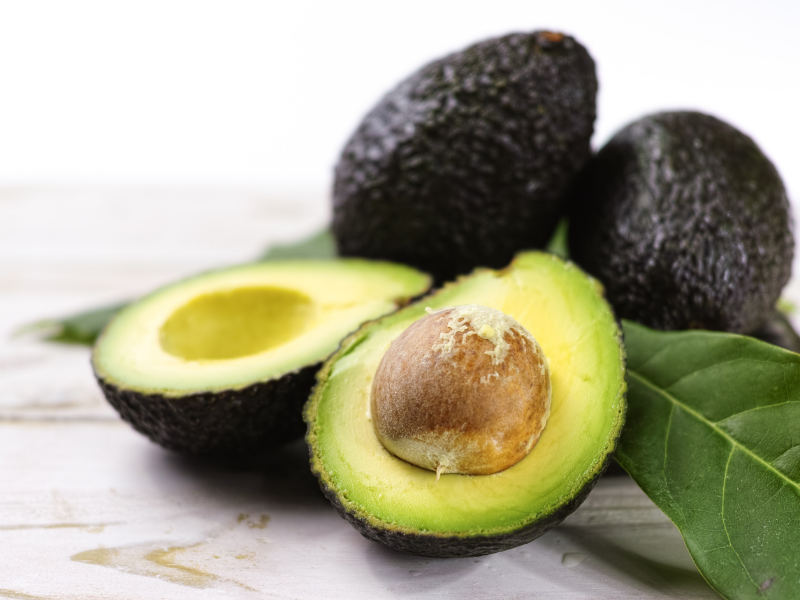
Avos really are the bomb when it comes to providing the healthiest unsaturated fat content, ensuring that you keep feeling fuller for longer during your fast periods. Several studies have shown that avocados and unsaturated fats keep your body feeling satiated for longer periods of time by signalling the body that it has been satisfactorily replenished, even in the middle of your fasting. And the best bit, even half an avo per day can make the difference – but make it a Hass avocado as they have been show to be the best!
3. Fish
Super rich in healthy omega 3, 6 and 9’s as well as a healthy dose of protein, fish (and seafood) provide a rich dose of vitamin D. Opt for oily fish such as sardines, kippers, salmon and mackerel. If you have a short window of opportunity to eat., choose food that provides the richest, abundant vitamins and minerals content to optimise your daily diet.
4. Green Veggies
Kale, broccoli, cabbage and asparagus provide the essential element to ensure you stay regular – fibre. These can also help to keep you feeling fuller for longer which is essential if you have another 12-16 hours ago before you eat again!!
5. Potatoes
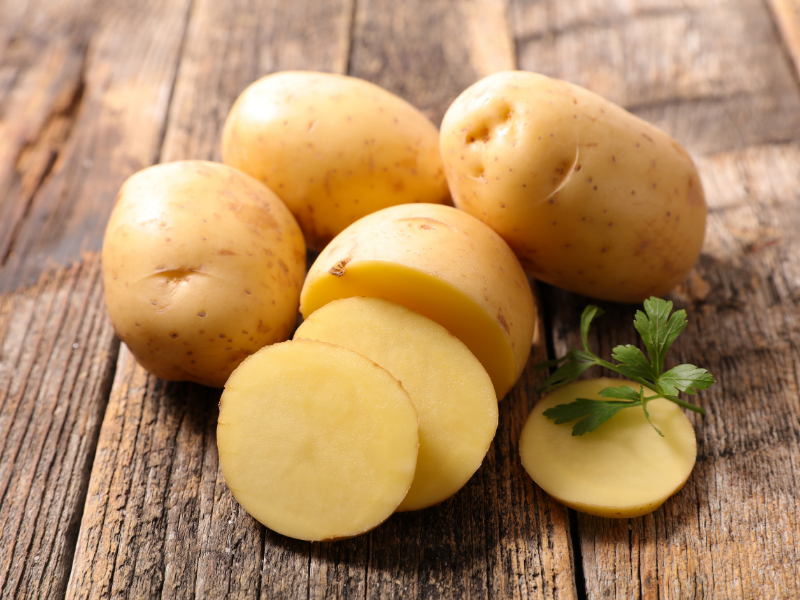
Excluding the fried versions of this Sir Walter Raleigh founded veggie, potatoes are a great way to fill your belly and hold you to not feel hungry during fasting. Studies have shown that the versatile potato is one of the most satiating foods – perfect for your fasting recipes.
6. Legumes
Legumes and beans offer a high carb content which can be enjoyed to help you feel full and perk you up during fasting. Beans, peas, lentils, chickpeas are great additions to bulk up dishes and help you overcome the dips that may occur when you fasting.
7. Eggs
Eggs are the king of protein offering a whopping 6.24 grams of protein in just one serving. They are fantastically versatile and cook up in minutes. Muscle mass is an issue for women over 50 so adding as much protein to the body as possible is essential for staying feeling full and building muscle, especially when you’re eating less. One study found that eating eggs reduces ghrelin (the hunger hormone) levels to significantly lower postprandial satiety and energy intake throughout the day.
Hard boiled eggs are the best and easiest choice for a mid morning snack, for when you are on the go and also to add to salads and sandwiches. Super easy.
8. Nuts & Seeds

Packed full of good, healthy fats, nuts are a great snack when eaten in moderation. They are of course calorie ladened so you need to take care of reaching for you many of these. A lower calorie option are walnuts or almonds which should be your go-to when fasting.
9. Whole Grains
Whole grains such as barley, buckwheat, bulgar, oatmeal, freekeh, wheat, quinoa, rice and amaranth all provide lots of fibre and protein, so eating a little goes a long way toward keeping you full.
The best part, popcorn is included in this list so when you feel hungry and need a low calorie snack, salted popcorn is a great option.
These are just a few examples of foods that can help support an dietary lifestyle that includes intermittent fasting and will go along way to ensure that you are able to stick to your new way of eating for improving health and wellbeing.
Top Tips for Intermittent Fasting Success!
- Plan your food shopping ahead of time (a week at a time) to ensure you have in your pantry exactly what you need.
- Avoid sugary and refined foods.
- Choose quality foods for optimal energy fuel such as those we mention above – fruits, green vegetables, legumes and beans, lean proteins, and healthy fats such as avocados.
- It’s inevitable that you will crave junk food so have a selection of healthy snacks to hand, even better if you make your own. Example: No Bake Protein Energy Balls or Vegan Trail Mix Cookies
- Avoid late-night snacking.
- Support your fasting with high quality protein and fibre rich snacks to help keep your appetite satiated.
- Cut out sugary beverages and diet sodas.
- Consume lots of water, black coffee, and herbal teas.
My Experience With Intermittent Fasting
My journey with intermittent fasting began because of reflux. I discovered if I stopped eating around 6pm, the reflux wasn’t as bad the next day. It soon became a habit and before I realised it, I was eating between 10am and 6pm quite naturally. I had naturally fallen into the 16:8 ratio meaning I ate within an 8-hour window and fasted for 16 hours. I have been eating life for over 2 years now.
During the 8-hour eating window, I eat regularly, which is generally healthy food and I manage two larger meals within that time frame and several healthy snacks. I eat breakfast around 10-10.30am and lunch around 2pm. A snack or piece of fruit around 5pm holds me until the next day.
During the 16 fasting hours, I drink herbal tea, water and coffee.
All that said, I am also what I like to refer to as IF flexible! I love to have a cup of tea first thing in the morning, and I drink it with milk, so this is technically breaking the fast. Also, if I am invited out one evening, then I am not going to sit there like a lemon and not join in, I will. And if I feel hungry in the morning before the 16-hour fast is up, I will eat. I use my 16:8 mode as an outline but with some flexibility when needed.
I listen to my body and it lets me know if something is off balance. And I adjust.
The result for me? I have definitely lost weight, improved my reflux symptoms, and it has helped reduce digestive/IBS issues. Simply put, I just feel good eating this way. It suits me and my lifestyle. But everyone is different. I think you should start slowly and see what feels right for you.
Intermittent Fasting: The Take Home
Intermittent fasting has become incredibly popular and offers some great results, especially for women midlife. It is a sustainable lifestyle because it doesn’t require you to deprive yourself all the time. For me, the best part of intermittent fasting is having freedom for food choice.
As with any dietary regime, caution should always be exercised because everyone is different and reacts in different ways. There are possible side effects with intermittent fasting and people with existing medical conditions such as IBS, or food issues should check in with a qualified dietitian or doctor who can support you and offer a personalised approach if you choose to go introduce intermittent fasting into your daily life for safe, effective results.
Good luck on your IF journey!
If you enjoyed this, you may also like:
Collagen – Can You Get Too Much?
6 Anti-Aging Teas You Need To Try
This Is How To Get Rid Of Your Turkey Neck
DISCLAIMER: MY WEBSITE DOES NOT PROVIDE MEDICAL ADVICE
The information, including but not limited to, text, graphics, images and other content contained on this website are for informational purposes only. No material on this site is intended to be a substitute for professional medical advice, diagnosis or treatment. Always seek the advice of your doctor with any questions you may have regarding a medical condition or treatment and before undertaking a new health care routine or product, and never disregard professional medical advice or delay in seeking it because of something you have read on this website.
______________________________________________________________________________________________________________________________
References:
Barnosky, A. R., Hoddy, K. K., Unterman, T. G., & Varady, K. A. (2014). Intermittent fasting vs daily calorie restriction for type 2 diabetes prevention: a review of human findings. Translational Research, 164(4), 302-311.
Baron, K. G., Reid, K. J., Van Horn, L., & Zee, P. C. (2013). Contribution of evening macronutrient intake to total caloric intake and body mass index. Appetite, 60, 246-251.
Baron, K. G., Reid, K. J., Kern, A. S., & Zee, P. C. (2011). Role of sleep timing in caloric intake and BMI. Obesity, 19(7), 1374-1381.
de Cabo, R., & Mattson, M. P. (2019). Effects of Intermittent Fasting on Health, Aging, and Disease. New England Journal of Medicine, 381(26), 2541-2551.
de Cabo R, Carmona-Gutierrez D, Bernier M, Hall MN, Madeo F. The search for antiaging interventions: from elixirs to fasting regimens. Cell. 2014;157(7):1515-1526. doi:10.1016/j.cell.2014.05.031
Heilbronn, L. K., Smith, S. R., Martin, C. K., Anton, S. D., & Ravussin, E. (2005). Alternate-day fasting in nonobese subjects: effects on body weight, body composition, and energy metabolism. The American journal of clinical nutrition, 81(1), 69-73.
Horne, B. D., Muhlestein, J. B., & Anderson, J. L. (2015). Health effects of intermittent fasting: hormesis or harm? A systematic review. The American journal of clinical nutrition, 102(2), 464-470.
Nair PM, Khawale PG. Role of therapeutic fasting in women’s health: An overview. J Midlife Health. 2016;7(2):61-64. doi:10.4103/0976-7800.185325
Rynders CA, Thomas EA, Zaman A, Pan Z, Catenacci VA, Melanson EL. Effectiveness of Intermittent Fasting and Time-Restricted Feeding Compared to Continuous Energy Restriction for Weight Loss. Nutrients. 2019;11(10):2442. Published 2019 Oct 14. doi:10.3390/nu11102442
Stockman MC, Thomas D, Burke J, Apovian CM. Intermittent Fasting: Is the Wait Worth the Weight?. Curr Obes Rep. 2018;7(2):172-185. doi:10.1007/s13679-018-0308-9

